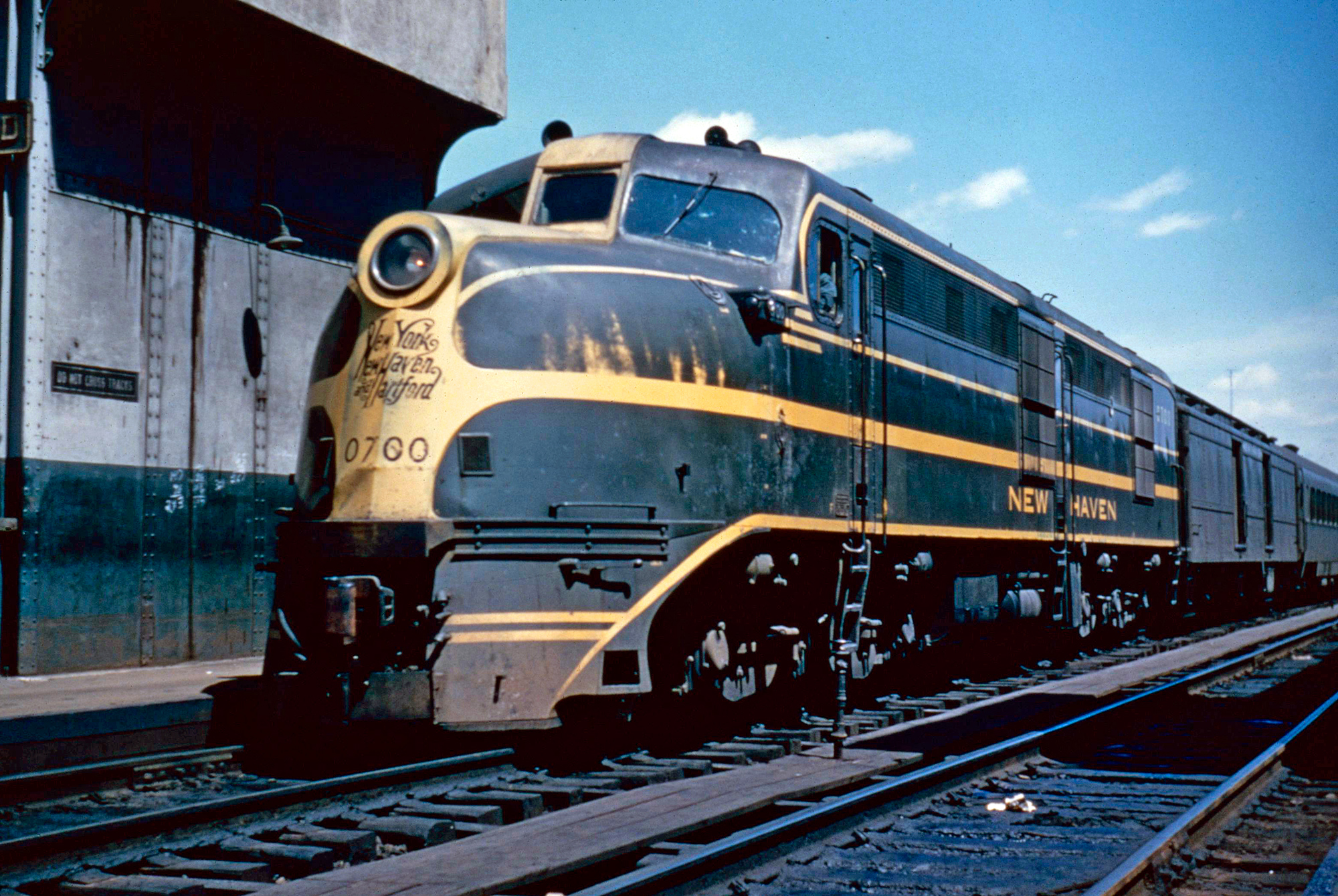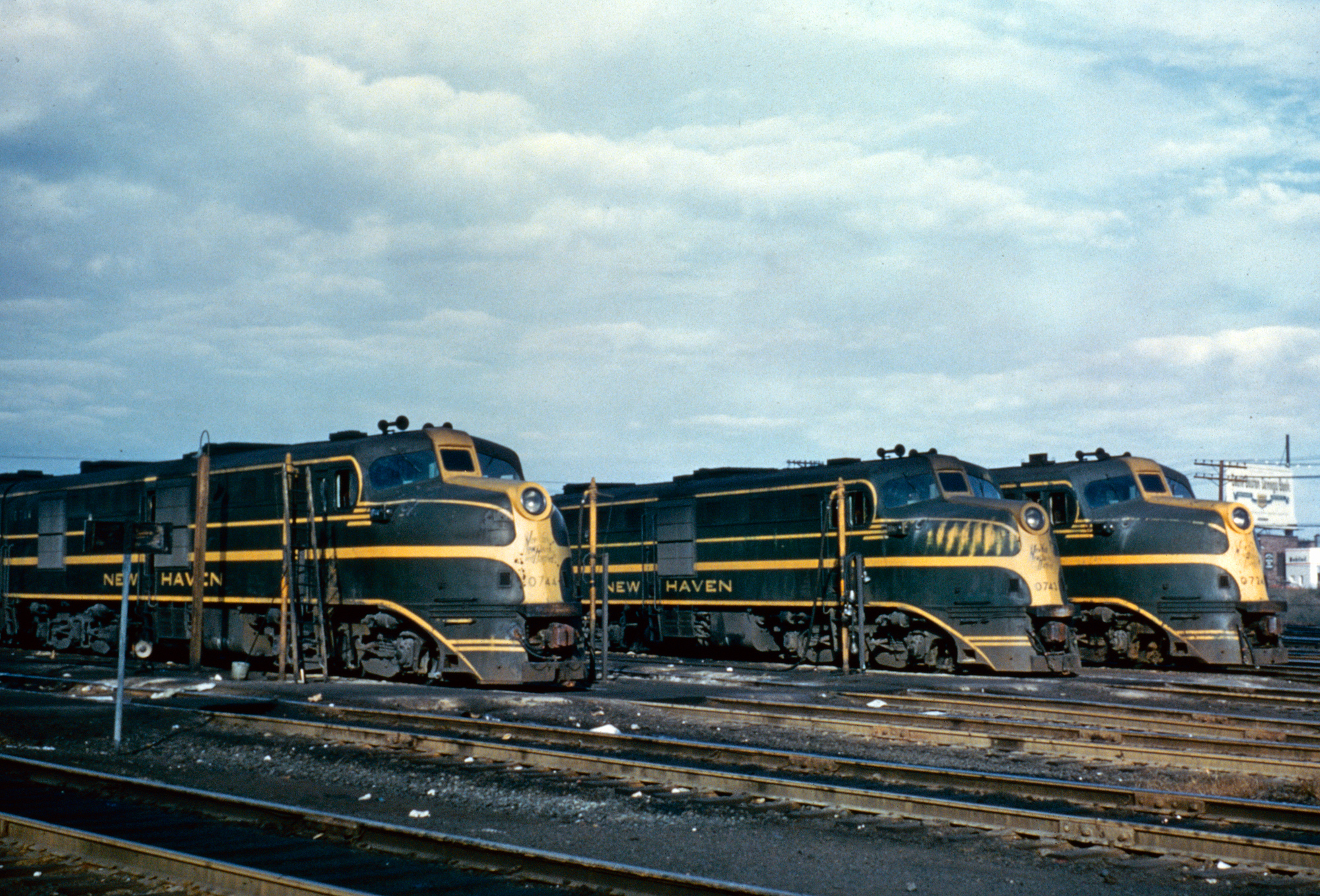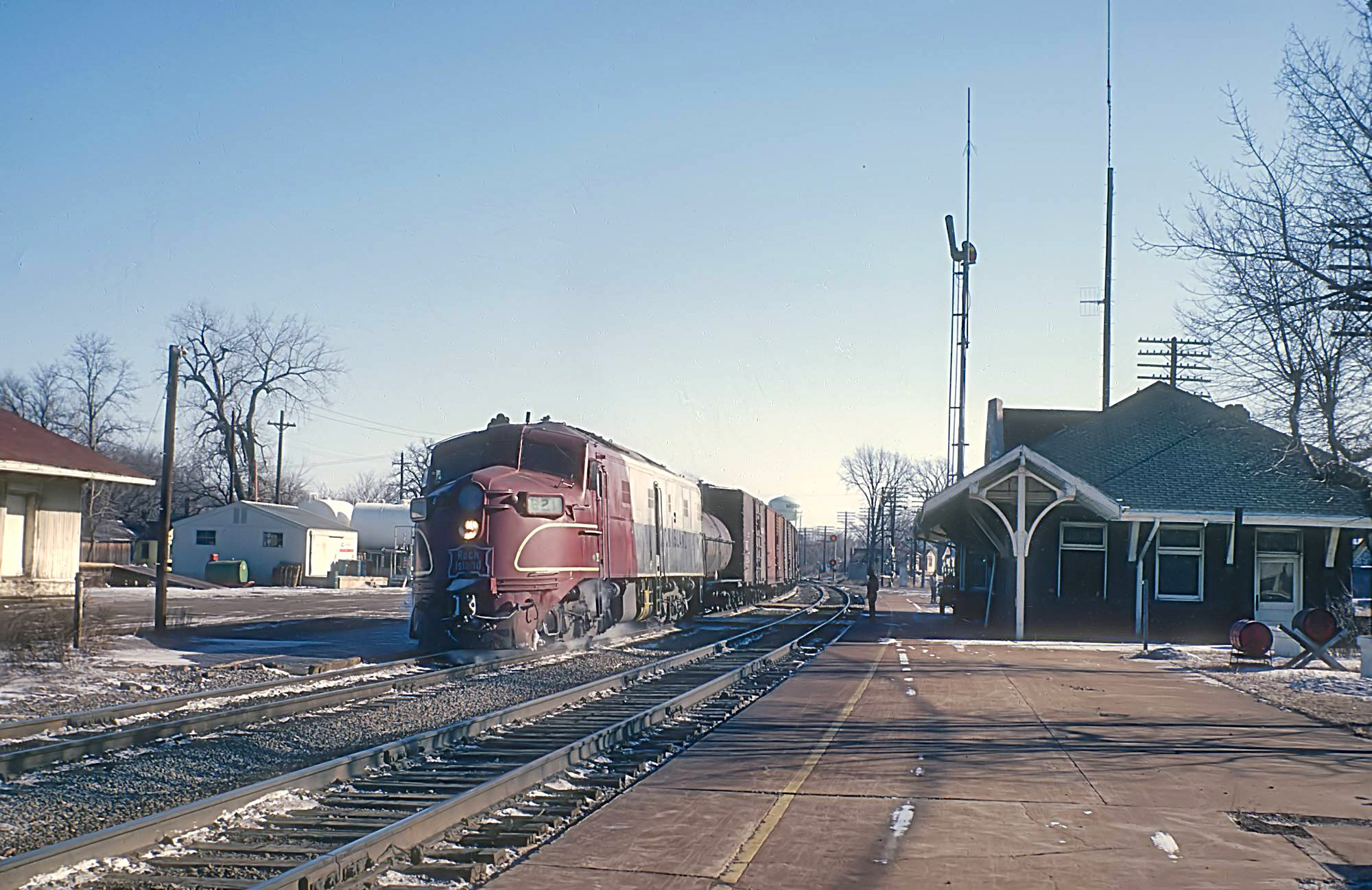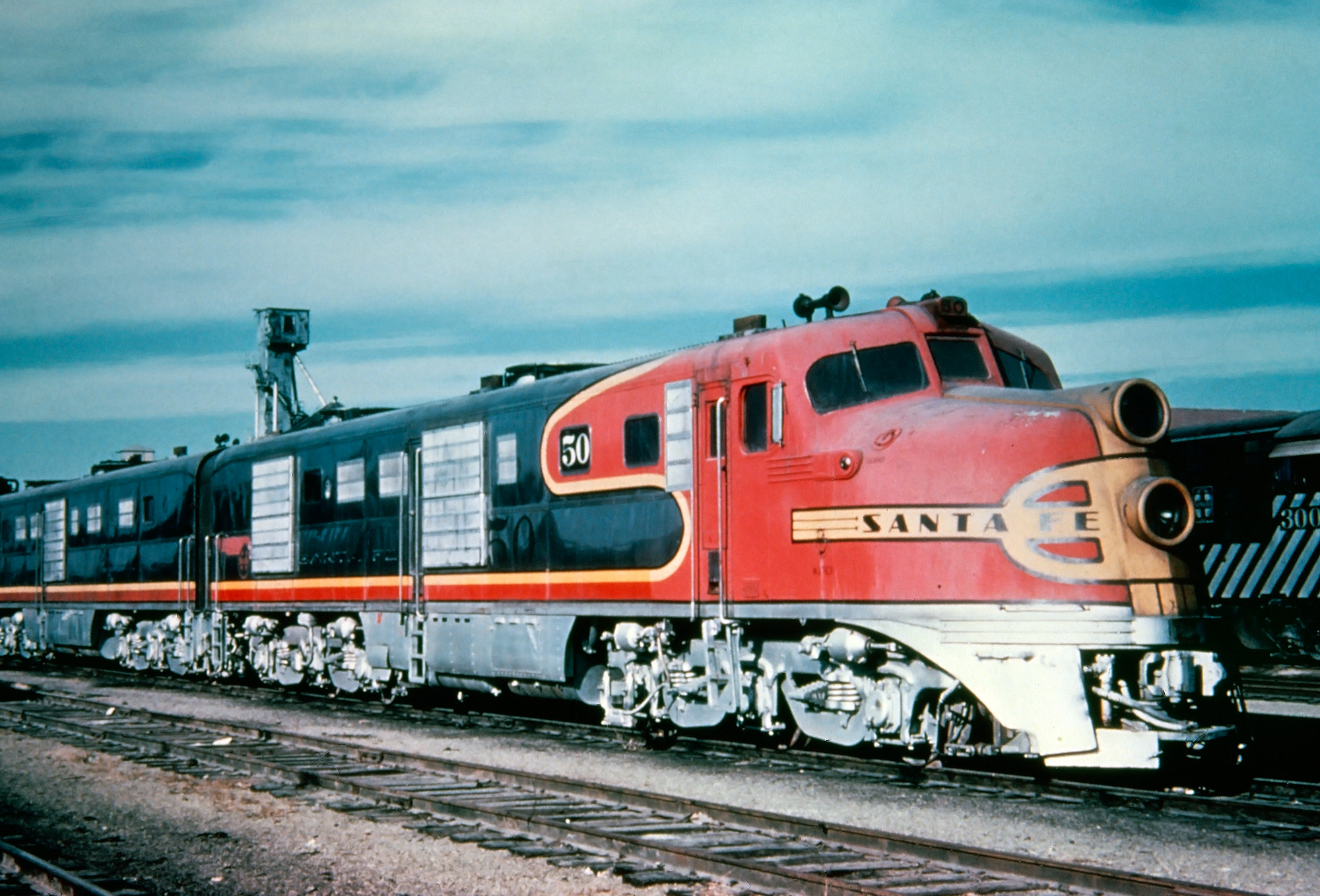Alco "DL-109" Locomotives: Data Sheet, Photos, History
Last revised: December 21, 2024
By: Adam Burns
The American Locomotive Company's first true production diesel was the DL series (the "DL" stood for Diesel Locomotive), a streamlined cab design similar to then-Electro-Motive Corporation's EA model of 1937.
The series would come in four different "models" (more on that below) although as John Kirkland notes, there was never any such designations made by Alco, the builder simply listed the entire production run as the DL-109/DL-110.
Overview
The locomotive was equipped with Alco's model 538T, and later 539T prime mover, a reliable engine that was utilized in most of its production model switchers. It appears the DL-109/DL-110 was more of a testbed series rather than a long-running cataloged model, perhaps partly due to the United States entering World War II, which disrupted diesel development.
When production had ended in 1945, to make way for the new FA/PA series, less than 100 DLs had been sold. Unfortunately, today, there are no known original DL units preserved as most were scrapped following their years of service.
Photos
 New Haven DL-109 #0700 has arrived at Springfield, Massachusetts during the 1950s. American-Rails.com collection.
New Haven DL-109 #0700 has arrived at Springfield, Massachusetts during the 1950s. American-Rails.com collection.The DL series essentially kicked off the builder's entrance into the mainstream diesel locomotive market. The American Locomotive Company had been dabbling in this market dating back to 1918 when it teamed up with General Electric and Ingersoll-Rand to design a motor car.
However, the company continued to remain focused on steam designs, believing this form of motive power would always remain the prevalent type even as Electro-Motive, later purchased by General Motors, began developing successful diesels as early as the 1920s.
At first EMC only constructed trainsets and small switchers but by the late 1930s it unveiled the passenger EA cab design, followed soon after by the freight FT model that revolutionized the industry.
This left Alco somewhat scrambling to unveil their own diesel locomotive. While the company proved it could manufacture a reliable, rugged, and efficient switcher their main line examples could simply never match what their competitor was producing.
The very first model was designated the DL-109 (it would later be sold to the Chicago, Rock Island & Pacific and given #624, completed on January 3, 1940) and used a pair of the company's 538T prime mover, which was a four-stroke diesel that produced 2,000 horsepower combined. The model's class listing was 606-DL345.
Its breakdown was as follow: "606" (6-wheel leading truck, no main drivers, 6-wheel trailing truck; no doubt this was a nod to the steam era classification), "DL" (Diesel Locomotive), and "345" (estimated weight, in thousands).
This engine was a product of Alco subsidiary McIntosh & Seymour of Auburn, New York. While Alco's diesels performed well in early switchers, they struggled in main line applications.
Eventually Alco would produce "four" models, which varied slightly. Aside from the DL-103b they included the DL-105, DL-107, and DL-109. Alco also produced two models of cabless "B" units the DL-108 and DL-110.
For purposes of clarity, these "four" models will discussed in detail here. However, they were not officially designated variants by Alco.
According to Brian Solomon's book Alco Locomotives, Schenectady simply described all variants of this model as the DL-109/DL-110. He goes on to state the different specification numbers given to the locomotives were coined after the fact.
This is further explained in John Kirkland's book, "The Diesel Builder's: Volume Two," detailing how railfans came up with the DL-103b, DL-105, and DL-107 designations on their own after studying various customer order files and noticing minute differences in various units.
As Kirkland explains, these changes only occurred months after the units had been in service when they were sent back to Schenectady for minor upgrades. Ultimately, Alco listed all of its first-generation passenger locomotives as DL-109 (A units) and DL-110 (B units).
The styling of the DL was thanks to noted industrial designer Otto Kuhler. Solomon states that Alco's cab model was essentially a mirror of Electro-Motive's save for the unique features Kuhler applied that sat it apart from its competitor.
Due to World War II restrictions Alco had difficulty in further developing not only the DL series but also diesel locomotive designs in general.
 New Haven Railroad DL-109's, including #0744, #0743, and #0724, at the Dover Street Yard in South Boston during the 1950s. American-Rails.com collection.
New Haven Railroad DL-109's, including #0744, #0743, and #0724, at the Dover Street Yard in South Boston during the 1950s. American-Rails.com collection.This was the case across the industry as the U.S. government, through the War Production Board (WPB), limited domestic production (especially in regards to passenger locomotives) in general and asked all manufacturers to focus efforts on producing goods strictly for the war effort.
It is somewhat interesting to wonder, had Alco been able to further refine its DL design could it have better competed with EMC/EMD? Despite the restrictions the builder was able to convince the board in allowing it to produce some 60 DL-109s for New Haven between December, 1941 and April, 1945: #0700–#0759.
This was only allowed as the locomotives were intended for dual passenger/freight assignments and given a 19:64 gear ratio according to Solomon while sporting General Electric's model GE-726 traction motors enabling 80 mph running.
Data Sheet and Specifications
Rock Island #624
| Alco Class | 606-DL-345 |
| Date Completed | 12/13/1939 (Began testing.) |
| Model Specification | DL-109 |
| Engine | 538T, 6-Cylinder In-Line (2), Turbocharged |
| Horsepower | 1,000 |
| RPM | 740 |
| Carbody Styling | Alco |
| Length (Between Coupler Pulling Faces) | 78' 11" |
| Weight | 339,000 Lbs. |
| Dynamic Brakes | No |
| Trucks | A1A-A1A |
| Truck Type | Trimount |
| Truck Wheelbase | 15' 4" |
| Wheel Size | 40" |
| Traction Motors | GE 730 |
| Traction Generator | GT542 |
| Gear Ratio | 25:58 |
| Top Speed | 120 MPH |
"A" Units
| Alco Class | 606-DL-345 |
| Entered Production | 9/20/1940 |
| Model Specification | DL-109 |
| Engine | 539T, 6-Cylinder In-Line (2), Turbocharged |
| Horsepower | 1,000 |
| RPM | 740 |
| Carbody Styling | Alco |
| Length (Between Coupler Pulling Faces) | 74' 6.5" |
| Weight | 331,700 - 357,500 Lbs. (Depending on options.) |
| Dynamic Brakes | No |
| Trucks | A1A-A1A |
| Truck Type | Trimount |
| Truck Wheelbase | 15' 4" |
| Wheel Size | 40" |
| Traction Motors | GE 726 (Freight), GE 730 (Passenger) |
| Traction Generator | GT557 |
| Gear Ratios | 25:58 (120 MPH), 22:61 (100 MPH), 21:71 (80 MPH), 19:64 (80 MPH) |
| Top Speed | 120 MPH |
"B" Units
| Alco Class | 606-DL-345 |
| Entered Production | 5/1/1941 (Santa Fe #50-A) |
| Model Specification | DL-110 |
| Engine | 539T, 6-Cylinder In-Line (2), Turbocharged |
| Horsepower | 1,000 |
| RPM | 740 |
| Carbody Styling | Alco |
| Length (Between Coupler Pulling Faces) | 72' 4" |
| Weight | 331,700 - 357,500 Lbs. (Depending on options.) |
| Dynamic Brakes | No |
| Trucks | A1A-A1A |
| Truck Type | Trimount |
| Truck Wheelbase | 15' 4" |
| Wheel Size | 40" |
| Traction Motors | GE 726 (Freight), GE 730 (Passenger) |
| Traction Generator | GT557 |
| Gear Ratios | 25:58 (120 MPH), 22:61 (100 MPH), 21:71 (80 MPH), 19:64 (80 MPH) |
| Top Speed | 120 MPH |
The breakdown in sales for the DL-109/DL-110 series is as follows, based on before World War II and during the conflict.
- Prior to the war, nine initial examples were completed for the Rock Island, GM&O, Rock Island, Santa Fe, and Southern. It is these units that were broken down by railfans as the "DL-103b," "DL-105," and "DL-107."
- In additional, 22 "A" units and 4 "B" units (the only ever built) were completed for the Milwaukee Road, Chicago & North Western, New Haven, and Gulf, Mobile & Ohio.
- Finally, the War Production Board permitted construction of 52 "A" units during the war; most went to the New Haven along with one each to the Southern and GM&O.
 Rock Island #621, an early Alco DL-109 model rebuilt with an EMD prime mover by this date and nicknamed "Christine," is seen here in freight service Morris, Illinois in March, 1967. Rick Burn photo.
Rock Island #621, an early Alco DL-109 model rebuilt with an EMD prime mover by this date and nicknamed "Christine," is seen here in freight service Morris, Illinois in March, 1967. Rick Burn photo.Overall, there were only minor differences among all of the DL locomotives produced. According to Solomon the DL-109 carbody was 74 feet, 6.5 inches long while the cabless DL-110 measured 72 feet, 4 inches long.
They were 9 feet, 10.5 inches wide and 13 feet, 6 inches tall. Additionally, the locomotives included turbo-charging and featured an A1A-A1A truck setup (meaning the two outside axles were powered with an unpowered center axle).
The New Haven, which always liked Alco products, also enjoyed their DL-109s, which were adorned in a gorgeous deep green with gold trim.
According to Solomon since the locomotives were geared for duel service the New Haven assigned them to the 157-mile New Haven to Boston route running two daily passenger assignments and then had them handle freights overnight.
Production Rosters
DL-109
| Railroad | Road Number | Construction Number | Completion Date |
|---|---|---|---|
| Rock Island | 624 | 69186 | 1/3/1940 |
| Gulf, Mobile & Ohio | 270 | 69334 | 9/20/1940 |
| Gulf, Mobile & Ohio | 271 | 69335 | 9/27/1940 |
| Rock Island | 622 | 69336 | 11/29/1940 |
| Rock Island | 623 | 69398 | 12/17/1940 |
| Santa Fe | 50 | 69399 | 5/1/1941 |
| Southern (Cincinnati, New Orleans & Texas Pacific) | 6400 | 69400 | 2/5/1941 |
| Southern (Cincinnati, New Orleans & Texas Pacific) | 6401 | 69401 | 2/6/1941 |
| Chicago & North Western | 5007A | 69436 | 8/1941 |
| Milwaukee Road | 14A | 69437 | 10/1941 |
| Milwaukee Road | 14B | 69438 | 10/1941 |
| Rock Island | 621 | 69439 | 11/1941 |
| New Haven | 0700-0703 | 69726-69729 | 12/1941 |
| New Haven | 0704 | 69730 | 1/1942 |
| New Haven | 0705 | 69731 | 2/1942 |
| New Haven | 0706 | 69732 | 3/1942 |
| New Haven | 0707-0709 | 69733-69735 | 4/1942 |
| Gulf, Mobile & Ohio | 272 | 69991 | 2/1943 |
| New Haven | 0710-0719 | 69980-69989 | 7/1942-1/1943 |
| New Haven | 0720-0729 | 71041-71050 | 1/1944-4/1944 |
| New Haven | 0730-0739 | 72950-72959 | 10/1944-1/1945 |
| New Haven | 0740-0744 | 72925-72929 | 1/1945-2/1945 |
| New Haven | 0745-0759 | 71439-71453 | 2/1945-4/1945 |
| Southern | 2904 | 69990 | 9/1942 |
DL-110
| Railroad | Road Number | Construction Number | Completion Date |
|---|---|---|---|
| Santa Fe | 50A | 69440 | 5/1/1941 |
| Southern (Cincinnati, New Orleans & Texas Pacific) | 6400B | 69441 | 2/1941 |
| Southern (Cincinnati, New Orleans & Texas Pacific) | 6401B | 69442 | 3/1941 |
| Southern (Cincinnati, New Orleans & Texas Pacific) | 6401C | 69443 | 11/1941 |
 Santa Fe's only DL-109/DL-110 set (#50-L/#50-A) is seen here stored at Argentine Yard (Kansas), circa 1960. American-Rails.com collection.
Santa Fe's only DL-109/DL-110 set (#50-L/#50-A) is seen here stored at Argentine Yard (Kansas), circa 1960. American-Rails.com collection.Interestingly, the Milwaukee Road is said to have used their DL-109s in service until the mid-1960s, logging more than 3 million and was rebuilt at least once and sported an Electro-Motive cab giving it the appearance as a GM-product.
The table listed above highlights each DL model and their total sales numbers. From a sales standpoint the DL series would be considered rather unsuccessful selling only 74 "A" and 4 "B" units total. This was a microcosm of Alco's problems with main line passenger and freight diesel locomotives.
Railroads often found the company's prime movers, particularly the 539T (which the DL-100 series was powered with), 241, and 244 models unreliable, troublesome, and rather complicated to maintain.
Even in later years when Alco developed a more reliable prime mover, the model 251, it appears the damage was already done among railroads, with most shying away from purchasing later models.
Recent Articles
-
Ferrocarriles Nacionales de México (N de M)
Jan 04, 26 11:52 PM
For much of the twentieth century, Ferrocarriles Nacionales de México—better known by its classic initials N de M, and later as FNM/Ferronales—served the heart of Mexico. -
Missouri Dinner Train Rides In Branson!
Jan 04, 26 07:00 PM
Nestled in the heart of the Ozarks, the Branson Scenic Railway offers one of the most distinctive rail experiences in the Midwest—pairing classic passenger railroading with sweeping mountain scenery a… -
Indiana Dinner Train Rides In Jasper
Jan 04, 26 06:32 PM
In the rolling hills of southern Indiana, the Spirit of Jasper offers one of those rare attractions that feels equal parts throwback and treat-yourself night out: a classic excursion train paired with…
Sources
- Kirkland, John F. Diesel Builders, The: Volume Two, American Locomotive Company And Montreal Locomotive Works. Glendale: Interurban Press, 1989.
- Pinkepank, Jerry A. Diesel Spotter's Guide. Milwaukee: Kalmbach Publishing Company, 1967.
- Schafer, Mike. Vintage Diesel Locomotives. Osceola: MBI Publishing, 1998.
- Solomon, Brian. Alco Locomotives. Minneapolis: Voyageur Press, 2009.
- Solomon, Brian. American Diesel Locomotive, The. Osceola: MBI Publishing, 2000.



